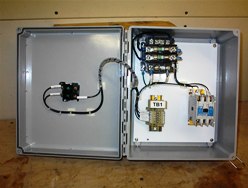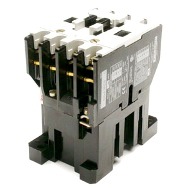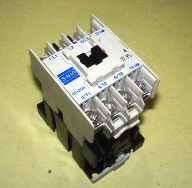Categories: Featured Articles » Novice electricians
Number of views: 55231
Comments on the article: 0
What you need to know about electromagnetic starters
Device application and classification of electromagnetic starters.
A bit of history
 A magnetic starter is a device designed to control power loads.
A magnetic starter is a device designed to control power loads.
For example, electric heaters, electric motors, induction furnaces, etc. Naturally, the question arises, why can not you turn on and off the load using a circuit breaker?
The fact is that the resource of the machine for turning on and off is at least an order of magnitude smaller than that of starter or contactor. In addition, the starter usually has a load current protection relay with adjustable current.
It so happened that the starter was designed to control asynchronous motors. In addition to current protection relays, the starter may include display devices, control buttons. All this is enclosed in a housing that protects the starter mechanisms from dust and moisture.
Magnetic starters are distinguished by purpose (conventional, reversible); the presence or absence of thermal relays; control buttons; degree of protection against external conditions, levels of operating currents, operating voltage of the coil.
A type electromagnetic starter and country of origin
 Of domestic starters, the PM12 series was most widely used; PLM PMU. Germany produces decent devices under the brands Siemens, ABB, Schneider electric, France Legrand. The starters of the joint Russian-Chinese company IEK proved to be quite good. For example, KMI-11860.
Of domestic starters, the PM12 series was most widely used; PLM PMU. Germany produces decent devices under the brands Siemens, ABB, Schneider electric, France Legrand. The starters of the joint Russian-Chinese company IEK proved to be quite good. For example, KMI-11860.
Starter current characteristics
Domestic starters are usually divided by operating currents by values 1-4. The first magnitude, the current is 10-16A, the second 25A, the third 40A, the fourth 63A. If the load is higher than 63A, then contactors are used. Imported starters are available for currents up to 100 A. For example, KMI-49562 95A.
The current of the main contacts of the starter must be greater than the maximum load current. It is worth remembering that the starting currents of electric motors can be several times higher than the operating currents. Always look at the passport for the device that you want to connect with a starter.
Starter coil operating voltage
The operating voltage of the starter coil must match the voltage of the control circuits. The standard range of values is 12, 24, 110, 220, 380 volts.
Degree of protection
 The degree of protection is selected based on the operating conditions of the device. It never hurts to have a degree of protection IP54. Such a device can work in dusty and humid conditions. If the starter is located in the control cabinet, then IP 20 is usually sufficient.
The degree of protection is selected based on the operating conditions of the device. It never hurts to have a degree of protection IP54. Such a device can work in dusty and humid conditions. If the starter is located in the control cabinet, then IP 20 is usually sufficient.
Thermal relay
If the starter turns on and off the motors, then a thermal protection relay in its composition is necessary. In modern starters, as a rule, there is such a relay.
Reversing starters
To control reversible electric motors there are starters with reverse. Such a starter contains two electromagnetic coils and six power contacts with mechanical interlock. In fact, these are two starters in one case.
Wear resistance
If the load operates in the mode of frequent switching on and off, this parameter becomes the most important for ensuring operability. In this case, it is worth considering the acquisition of contactless starters. They also have their own advantages and disadvantages. First of all, it is noise immunity and dependence on the supply voltage and, of course, a higher price.
Human factor
Do not forget that any device needs timely prevention and care. Competent staff in the future saves more money to any company than inept, but "cheap" guest workers. You can even break a crowbar. You should always listen to specialists and pay them a decent salary. This is the key to the prosperity of any company and the basis for its worthy reputation in the market.
Connection diagrams of the magnetic starter: How to connect a magnetic starter
See also at e.imadeself.com
:
